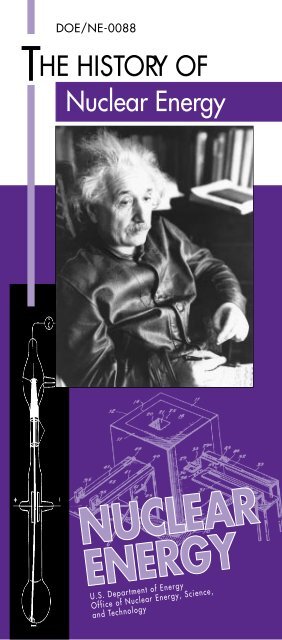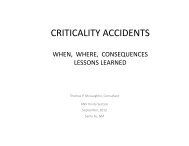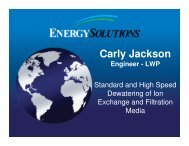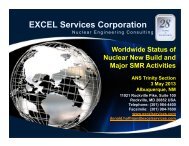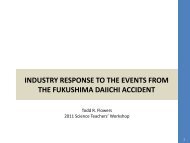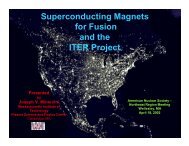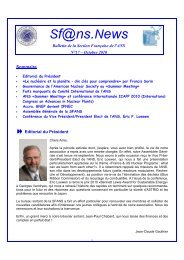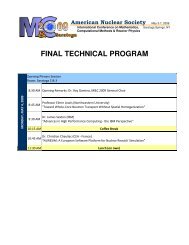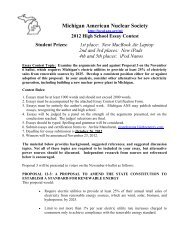DOE-NE-0088
DOE-NE-0088
DOE-NE-0088
You also want an ePaper? Increase the reach of your titles
YUMPU automatically turns print PDFs into web optimized ePapers that Google loves.
<strong>DOE</strong>/<strong>NE</strong>-<strong>0088</strong><br />
THE HISTORY OF<br />
Nuclear Energy<br />
NUCLEAR<br />
E<strong>NE</strong>RGY<br />
U.S. Department of Energy<br />
Office of Nuclear Energy, Science,<br />
and Technology
OnOn the<br />
On<br />
On the cover:<br />
Albert Einstein (1879–1955)
The History of<br />
Nuclear Energy<br />
Table of Contents<br />
Preface<br />
1<br />
Introduction<br />
3<br />
The Discovery of Fission<br />
4<br />
The First Self-Sustaining Chain Reaction<br />
5<br />
The Development of Nuclear Energy<br />
for Peaceful Applications<br />
7<br />
Chronology of Nuclear Research and<br />
Development, 1942-1994<br />
13<br />
Selected References<br />
23<br />
Glossary<br />
27<br />
U.S. Department of Energy<br />
Office of Nuclear Energy, Science, and Technology<br />
Washington, D.C. 20585<br />
i
The History<br />
Of Nuclear Energy<br />
Energy From The Atom<br />
Although they are tiny, atoms have a large<br />
amount of energy holding their nuclei together.<br />
Certain isotopes of some elements can be split<br />
and will release part of their energy as heat.<br />
This splitting is called fission. The heat released<br />
in fission can be used to help generate electricity<br />
in powerplants.<br />
Uranium-235 (U-235) is one of the isotopes that<br />
fissions easily. During fission, U-235 atoms<br />
absorb loose neutrons. This causes U-235 to<br />
become unstable and split into two light atoms<br />
called fission products.<br />
The combined mass of the fission products is<br />
less than that of the original U-235. The<br />
reduction occurs<br />
because some of the<br />
matter changes into<br />
energy. The energy is<br />
released as<br />
heat. Two<br />
or<br />
three<br />
neutrons are<br />
released along with the<br />
heat. These neutrons<br />
may hit other atoms,<br />
causing more fission.<br />
ii
A series of fissions is called a chain reaction. If<br />
enough uranium is brought together under the<br />
right conditions, a continuous chain reaction<br />
occurs. This is called a self-sustaining chain<br />
reaction. A self-sustaining chain reaction creates<br />
a great deal of heat, which can be used to help<br />
generate electricity.<br />
Nuclear powerplants generate electricity like<br />
any other steam-electric powerplant. Water is<br />
heated, and steam from the boiling water turns<br />
turbines and generates electricity. The main<br />
difference in the various types of steam-electric<br />
plants is the heat source. Heat from a selfsustaining<br />
chain reaction boils the water in a<br />
nuclear powerplant. Coal, oil, or gas is burned<br />
in other powerplants to heat the water.<br />
iii
Preface<br />
The concept of the atom has existed for many<br />
centuries. But we only recently began to<br />
understand the enormous power contained in<br />
the tiny mass.<br />
In the years just before and during World War<br />
II, nuclear research focused mainly on the<br />
development of defense weapons. Later,<br />
scientists concentrated on peaceful applications<br />
of nuclear technology. An important use of<br />
nuclear energy is the generation of electricity.<br />
After years of research, scientists have successfully<br />
applied nuclear technology to many other<br />
scientific, medical, and industrial purposes.<br />
This pamphlet traces the history of our<br />
discoveries about atoms. We begin with the<br />
ideas of the Greek philosophers. Then we<br />
follow the path to the early scientists who<br />
discovered radioactivity. Finally, we reach<br />
modern-day use of atoms as a valuable<br />
source of energy.<br />
This pamphlet also includes a detailed<br />
chronology of the history of nuclear energy and<br />
a glossary. We hope the glossary will explain<br />
terms that may be new to some readers and<br />
that studying the chronology will encourage<br />
readers to explore the resources listed in the<br />
bibliography. By doing so, you can discover<br />
first-hand our nation’s efforts to develop and<br />
control this powerful technology.<br />
1
Introduction<br />
It is human nature to test, to observe, and to<br />
dream. The history of nuclear energy is the<br />
story of a centuries-old dream becoming a<br />
reality.<br />
Ancient Greek philosophers first developed the<br />
idea that all matter is composed of invisible<br />
particles called atoms. The word atom comes<br />
from the Greek word, atomos, meaning<br />
indivisible. Scientists in the 18th and 19th<br />
centuries revised the concept based on their<br />
experiments. By 1900, physicists knew the atom<br />
contains large quantities of energy. British<br />
physicist Ernest Rutherford was called the<br />
father of nuclear science because of his<br />
contribution to the theory of atomic structure.<br />
In 1904 he wrote:<br />
If it were ever possible to control at will the rate of<br />
disintegration of the radio elements, an enormous<br />
amount of energy could be obtained from a small<br />
amount of matter.<br />
Albert Einstein developed his theory of the<br />
relationship between mass and energy one year<br />
later. The mathematical formula is E=mc 2 , or<br />
“energy equals mass times the speed of light<br />
squared.” It took almost 35 years for someone<br />
to prove Einstein’s theory.<br />
3
The Discovery Of<br />
Fission<br />
In 1934, physicist Enrico Fermi conducted<br />
experiments in Rome that showed neutrons<br />
could split many kinds of atoms. The results<br />
surprised even Fermi himself. When he<br />
bombarded uranium with neutrons, he did<br />
not get the elements he expected. The elements<br />
were much lighter than uranium.<br />
Enrico Fermi, an Italian physicist, led the team of scientists who created<br />
the first self-sustaining nuclear chain reaction.<br />
In the fall of 1938, German scientists Otto Hahn<br />
and Fritz Strassman fired neutrons from a<br />
source containing the elements radium and<br />
beryllium into uranium (atomic number 92).<br />
They were surprised to find lighter elements,<br />
such as barium (atomic number 56), in the<br />
leftover materials.<br />
4
These elements had about half the atomic mass<br />
of uranium. In previous experiments, the<br />
leftover materials were only slightly lighter<br />
than uranium.<br />
Hahn and Strassman contacted Lise Meitner in<br />
Copenhagen before publicizing their discovery.<br />
She was an Austrian colleague who had<br />
been forced to flee Nazi Germany. She worked<br />
with Niels Bohr and her nephew, Otto R.<br />
Frisch. Meitner and Frisch thought the barium<br />
and other light elements in the leftover<br />
material resulted from the uranium splitting —<br />
or fissioning. However, when she added the<br />
atomic masses of the fission products, they did<br />
not total the uranium’s mass. Meitner used<br />
Einstein’s theory to show the lost mass<br />
changed to energy. This proved fission<br />
occurred and confirmed Einstein’s work.<br />
The First<br />
Self-Sustaining<br />
Chain Reaction<br />
In 1939, Bohr came to America. He shared with<br />
Einstein the Hahn-Strassman-Meitner discoveries.<br />
Bohr also met Fermi at a conference on<br />
theoretical physics in Washington, D.C. They<br />
discussed the exciting possibility of a selfsustaining<br />
chain reaction. In such a process,<br />
atoms could be split to release large amounts<br />
of energy.<br />
Scientists throughout the world began to<br />
believe a self-sustaining chain reaction might<br />
be possible. It would happen if enough<br />
uranium could be brought together under<br />
proper conditions. The amount of uranium<br />
needed to make a self-sustaining chain reaction<br />
is called a critical mass.<br />
5
Fermi and his associate, Leo Szilard, suggested<br />
a possible design for a uranium chain reactor<br />
in 1941. Their model consisted of uranium<br />
placed in a stack of graphite to make a cubelike<br />
frame of fissionable material.<br />
Leo Szilard<br />
Early in 1942, a group of scientists led by Fermi<br />
gathered at the University of Chicago to<br />
develop their theories. By November 1942,<br />
they were ready for construction to begin on<br />
the world’s first nuclear reactor, which became<br />
known as Chicago Pile-1. The pile was erected<br />
on the floor of a squash court beneath the<br />
University of Chicago’s athletic stadium. In<br />
addition to uranium and graphite, it contained<br />
control rods made of cadmium. Cadmium is a<br />
metallic element that absorbs neutrons. When<br />
the rods were in the pile, there were fewer<br />
neutrons to fission uranium atoms. This<br />
slowed the chain reaction. When the rods were<br />
pulled out, more neutrons were available to<br />
split atoms. The chain reaction sped up.<br />
6
On the morning of December 2, 1942, the<br />
scientists were ready to begin a demonstration<br />
of Chicago Pile-1. Fermi ordered the control<br />
rods to be withdrawn a few inches at a time<br />
during the next several hours. Finally, at 3:25<br />
p.m., Chicago time, the nuclear reaction<br />
became self-sustaining. Fermi and his group<br />
had successfully transformed scientific theory<br />
into technological reality. The world had<br />
entered the nuclear age.<br />
The Development Of<br />
Nuclear Energy For<br />
Peaceful Applications<br />
The first nuclear reactor was only the beginning.<br />
Most early atomic research focused on<br />
developing an effective weapon for use in<br />
World War II. The work was done under the<br />
code name Manhattan Project.<br />
Lise Meitner and Otto R. Frisch<br />
7
However, some scientists worked on making<br />
breeder reactors, which would produce fissionable<br />
material in the chain reaction. Therefore,<br />
they would create more fissionable material<br />
than they would use.<br />
Enrico Fermi led a group of scientists in initiating the first<br />
self-sustaining nuclear chain reaction. The historic event, which<br />
occurred on December 2, 1942, in Chicago, is recreated in this painting.<br />
After the war, the United States government<br />
encouraged the development of nuclear energy<br />
for peaceful civilian purposes. Congress<br />
created the Atomic Energy Commission (AEC)<br />
in 1946. The AEC authorized the construction<br />
of Experimental Breeder Reactor I at a site in<br />
Idaho. The reactor generated the first electricity<br />
from nuclear energy on December 20, 1951.<br />
8<br />
A major goal of nuclear research in the<br />
mid-1950s was to show that nuclear energy<br />
could produce electricity for commercial use.<br />
The first commercial electricity-generating<br />
plant powered by nuclear energy was located<br />
in Shippingport, Pennsylvania. It reached its<br />
full design power in 1957. Light-water reactors<br />
like Shippingport use ordinary water to cool<br />
the reactor core during the chain reaction.<br />
They were the best design then available for<br />
nuclear powerplants.<br />
Private industry became more and more<br />
involved in developing light-water reactors<br />
after Shippingport became operational.
Federal nuclear energy programs shifted their<br />
focus to developing other reactor technologies.<br />
The nuclear power industry in the U.S. grew<br />
rapidly in the 1960s. Utility companies saw<br />
this new form of electricity production as<br />
economical, environmentally clean, and safe.<br />
In the 1970s and 1980s, however, growth<br />
slowed. Demand for electricity decreased and<br />
concern grew over nuclear issues, such as<br />
reactor safety, waste disposal, and other<br />
environmental considerations.<br />
Still, the U.S. had twice as many operating<br />
nuclear powerplants as any other country in<br />
1991. This was more than one-fourth of the<br />
world’s operating plants. Nuclear energy<br />
supplied almost 22 percent of the electricity<br />
produced in the U.S.<br />
The Experimental Breeder Reactor I generated electricity to light four<br />
200-watt bulbs on December 20, 1951. This milestone symbolized the<br />
beginning of the nuclear power industry.<br />
9
At the end of 1991, 31 other countries also had<br />
nuclear powerplants in commercial operation<br />
or under construction. That is an impressive<br />
worldwide commitment to nuclear power<br />
technology.<br />
During the 1990s, the U.S. faces several major<br />
energy issues and has developed several major<br />
goals for nuclear power, which are:<br />
◆ To maintain exacting safety and design<br />
standards;<br />
◆ To reduce economic risk;<br />
◆ To reduce regulatory risk;<br />
and<br />
◆ To establish an effective high-level nuclear<br />
waste disposal program.<br />
Several of these nuclear power goals were<br />
addressed in the Energy Policy Act of 1992,<br />
which was signed into law in October of<br />
that year.<br />
The U.S. is working to achieve these goals in a<br />
number of ways. For instance, the U.S. Department<br />
of Energy has undertaken a number<br />
of joint efforts with the nuclear industry to<br />
develop the next generation of nuclear<br />
powerplants. These plants are being designed<br />
to be safer and more efficient. There is also an<br />
effort under way to make nuclear plants easier<br />
to build by standardizing the design and<br />
simplifying the licensing requirements, without<br />
lessening safety standards.<br />
10<br />
In the area of waste management, engineers are<br />
developing new methods and places to store the<br />
radioactive waste produced by nuclear plants<br />
and other nuclear processes. Their goal is to<br />
keep the waste away from the environment and<br />
people for very long periods of<br />
20<br />
time.
Scientists are also studying the power of<br />
nuclear fusion. Fusion occurs when atoms join<br />
— or fuse — rather than split. Fusion is the<br />
energy that powers the sun. On earth, the most<br />
promising fusion fuel is deuterium, a form of<br />
hydrogen. It comes from water and is plentiful.<br />
It is also likely to create less radioactive waste<br />
than fission. However, scientists are still unable<br />
to produce useful amounts of power from<br />
fusion and are continuing their research.<br />
In Oak Ridge, Tennessee, workers package isotopes, which are<br />
commonly used in science, industry, and medicine.<br />
21 11
Research in other nuclear areas is also<br />
continuing in the 1990s. Nuclear technology<br />
plays an important role in medicine,<br />
industry, science, and food and agriculture, as<br />
well as power generation. For example,<br />
doctors use radioisotopes to identify and<br />
investigate the causes of disease.<br />
They also use them to enhance traditional<br />
medical treatments. In industry,<br />
radioisotopes are used for measuring<br />
microscopic thicknesses, detecting irregularities<br />
in metal casings, and testing welds.<br />
Archaeologists use nuclear techniques to date<br />
prehistoric objects accurately and to locate<br />
structural defects in statues and buildings.<br />
Nuclear irradiation is used in preserving food.<br />
It causes less vitamin loss than canning,<br />
freezing, or drying.<br />
Nuclear research has benefited mankind in<br />
many ways. But today, the nuclear industry<br />
faces huge, very complex issues. How can we<br />
minimize the risk? What do we do with the<br />
waste? The future will depend on advanced<br />
engineering, scientific research, and the<br />
involvement of an enlightened citizenry.<br />
12<br />
18
Chronology of<br />
Nuclear Research and<br />
Development<br />
The '40s<br />
1942 December 2. The first self-sustaining nuclear<br />
chain reaction occurs at the University of Chicago.<br />
1945 July 16. The U.S. Army’s Manhattan Engineer<br />
District (MED) tests the first atomic bomb at<br />
Alamogordo, New Mexico, under the code name<br />
Manhattan Project.<br />
1945 August 6. The atomic bomb nicknamed Little<br />
Boy is dropped on Hiroshima, Japan. Three days<br />
later, another bomb, Fat Man, is dropped on<br />
Nagasaki, Japan. Japan surrenders on August 15,<br />
ending World War II.<br />
1946 August 1. The Atomic Energy Act of 1946<br />
creates the Atomic Energy Commission (AEC) to<br />
control nuclear energy development and explore<br />
peaceful uses of nuclear energy.<br />
1947 October 6. The AEC first investigates the<br />
possibility of peaceful uses of atomic energy, issuing<br />
a report the following year.<br />
1949 March 1. The AEC announces the selection of a<br />
site in Idaho for the National Reactor Testing<br />
Station.<br />
The '50s<br />
1951 December 20. In Arco, Idaho, Experimental<br />
Breeder Reactor I produces the first electric power<br />
from nuclear energy, lighting four light bulbs.<br />
1952 June 14. Keel for the Navy's first nuclear<br />
submarine, Nautilus, is laid at Groton,<br />
Connecticut.<br />
19 13
1953 March 30. Nautilus starts its nuclear power<br />
units for the first time.<br />
1953 December 8. President Eisenhower delivers<br />
his "Atoms for Peace" speech before the United<br />
Nations. He calls for greater international cooperaton<br />
in the development of atomic energy for<br />
peaceful purposes.<br />
1954 August 30. President Eisenhower signs The<br />
Atomic Energy Act of 1954, the first major amendment<br />
of the original Atomic Energy Act, giving the<br />
civilian nuclear power program further access to<br />
nuclear technology.<br />
1955 January 10. The AEC announces the Power<br />
Demonstration Reactor Program. Under the<br />
program, AEC and industry will cooperate in<br />
constructing and operating experimental nuclear<br />
power reactors.<br />
1955 July 17. Arco, Idaho, population 1,000,<br />
becomes the first town powered by a nuclear<br />
powerplant, the experimental boiling water<br />
reactor BORAX III.<br />
1955 August 8-20. Geneva, Switzerland, hosts the<br />
first United Nations International Conference on<br />
the Peaceful Uses of Atomic Energy.<br />
1957 July 12. The first power from a civilian nuclear<br />
unit is generated by the Sodium Reactor Experiment<br />
at Santa Susana, California. The unit provided<br />
power until 1966.<br />
1957 September 2. The Price-Anderson Act provides<br />
financial protection to the public and AEC licensees<br />
and contractors if a major accident occurs at a<br />
nuclear powerplant.<br />
14<br />
The Nautilus-the First Atomic-Powered Sub
1957 October 1. The United Nations creates the<br />
International Atomic Energy Agency (IAEA) in<br />
Vienna, Austria, to promote the peaceful use of<br />
nuclear energy and prevent the spread of nuclear<br />
weapons around the world.<br />
1957 December 2. The world’s first large-scale<br />
nuclear powerplant begins operation in<br />
Shippingport, Pennsylvania. The plant reaches<br />
full power three weeks later and supplies electricity<br />
to the Pittsburgh area.<br />
1958 May 22. Construction begins on the world's<br />
first nuclear-powered merchant ship, the N.S.<br />
Savannah, in Camden, New Jersey. The ship is<br />
launched July 21, 1959.<br />
1959 October 15. Dresden-1 Nuclear Power<br />
Station in Illinois, the first U.S. nuclear plant built<br />
entirely without government funding, achieves a<br />
self-sustaining nuclear reaction.<br />
The '60s<br />
1960 August 19. The third U.S. nuclear<br />
powerplant, Yankee Rowe Nuclear Power Station,<br />
achieves a self-sustaining nuclear reacton.<br />
Early 1960s. Small nuclear-power generators are<br />
first used in remote areas to power weather<br />
stations and to light buoys for sea navigation.<br />
NS Savannah<br />
15
1961 November 22. The U.S. Navy commissions<br />
the world’s largest ship, the U.S.S.<br />
Enterprise. It is a nuclear-powered aircraft<br />
carrier with the ability to operate at speeds up<br />
to 30 knots for distances up to 400,000 miles<br />
(740,800 kilometers) without refueling.<br />
1964 August 26. President Lyndon B. Johnson<br />
signs the Private Ownership of Special Nuclear<br />
Materials Act, which allows the nuclear power<br />
industry to own the fuel for its units. After<br />
June 30, 1973, private ownership of the<br />
uranium fuel is mandatory.<br />
1963 December 12. Jersey Central Power and<br />
Light Company announces its commitment for<br />
the Oyster Creek nuclear powerplant, the first<br />
time a nuclear plant is ordered as an economic<br />
alternative to a fossil-fuel plant.<br />
An atomic battery operated on the moon continuously for three years.<br />
Nuclear electric power arrived on the moon for the first time on<br />
November 19, 1969, when the Apollo 12 astronauts deployed the<br />
AEC's SNAP-27 nuclear generator on the lunar surface.<br />
16
1964 October 3. Three nuclear-powered<br />
surface ships, the Enterprise, Long Beach, and<br />
Bainbridge, complete “Operation Sea Orbit,”<br />
an around-the-world cruise.<br />
1965 April 3. The first nuclear reactor in space<br />
(SNAP-10A) is launched by the United States.<br />
SNAP stands for Systems for Nuclear Auxiliary<br />
Power.<br />
The '70s<br />
1970 March 5. The United States, United<br />
Kingdom, Soviet Union, and 45 other nations<br />
ratify the Treaty for Non-Proliferation of<br />
Nuclear Weapons.<br />
1971 Twenty-two commercial nuclear<br />
powerplants are in full operation in the United<br />
States. They produce 2.4 percent of U.S.<br />
electricity at this time.<br />
1973 U.S. utilities order 41nuclear<br />
powerplants, a one-year record.<br />
1974 The first 1,000-megawatt-electric nuclear<br />
powerplant goes into service – Commonwealth<br />
Edison's Zion 1 Plant.<br />
1974 October 11. The Energy Reorganization<br />
Act of 1974 divides AEC functions between<br />
two new agencies — the Energy Research and<br />
Development Administration (ERDA), to<br />
carry out research and development, and the<br />
Nuclear Regulatory Commission (NRC), to<br />
regulate nuclear power.<br />
1977 April 7. President Jimmy Carter<br />
announces the United States will defer<br />
indefinitely plans for reprocessing spent<br />
nuclear fuel.<br />
17
1977 August 4. President Carter signs the<br />
Department of Energy Organization Act,<br />
which transfers ERDA functions to the new<br />
Department of Energy (<strong>DOE</strong>).<br />
1977 October 1. <strong>DOE</strong> begins operations.<br />
1979 March 28. The worst accident in U.S.<br />
commercial reactor history occurs at the<br />
Three Mile Island nuclear power station near<br />
Harrisburg, Pennsylvania. The accident is<br />
caused by a loss of coolant from the reactor<br />
core due to a combination of mechanical<br />
malfunction and human error. No one is<br />
injured, and no overexposure to radiation<br />
results from the accident. Later in the year, the<br />
NRC imposes stricter reactor safety regulations<br />
and more rigid inspection procedures to<br />
improve the safety of reactor operations.<br />
1979 Seventy-two licensed reactors generate<br />
12 percent of the electricity produced commercially<br />
in the United States.<br />
The '80s<br />
1980 March 26. <strong>DOE</strong> initiates the Three Mile<br />
Island research and development program to<br />
develop technology for disassembling and<br />
de-fueling the damaged reactor. The program<br />
will continue for 10 years and make<br />
significant advances in developing new<br />
nuclear safety technology.<br />
1982 October 1. After 25 years of service, the<br />
Shippingport Power Station is shut down.<br />
Decommissioning would be completed in<br />
1989.<br />
18<br />
1983 January 7. The Nuclear Waste Policy Act<br />
(NWPA) establishes a program to site a<br />
repository for the disposal of high-level
adioactive waste, including spent fuel from<br />
nuclear powerplants. It also establishes fees<br />
for owners and generators of radioactive<br />
waste and spent fuel, who pay the costs of<br />
the program.<br />
1983 Nuclear power generates more electricity<br />
than natural gas.<br />
1984 The atom overtakes hydropower to<br />
become the second largest source of electricity,<br />
after coal. Eighty-three nuclear power reactors<br />
provide about 14 percent of the electricity<br />
produced in the United States.<br />
1985 The Institute of Nuclear Power Operations<br />
forms a national academy to accredit<br />
every nuclear powerplant's training program.<br />
1986 The Perry Power Plant in Ohio becomes<br />
the 100th U.S. nuclear powerplant in operation.<br />
1986 April 26. Operator error causes two<br />
explosions at the Chernobyl No. 4 nuclear<br />
powerplant in the former Soviet Union. The<br />
reactor has an inadequate containment<br />
building, and large amounts of radiation<br />
escape. A plant of such design would not be<br />
licensed in the United States.<br />
1987 December 22. The Nuclear Waste<br />
Policy Act (NWPA) is amended. Congress<br />
directs <strong>DOE</strong> to study only the potential of the<br />
Yucca Mountain, Nevada, site for disposal of<br />
high-level radioactive waste.<br />
1988 U.S. electricity demand is 50 percent<br />
higher than in 1973.<br />
1989 One hundred and nine nuclear<br />
powerplants provide 19 percent of the<br />
electricity used in the U.S.; 46 units have<br />
entered service during the decade. 19
1989 April 18. The NRC proposes a plan for reactor<br />
design certification, early site permits, and<br />
combined construction and operating licenses.<br />
The '90s<br />
1990 March. <strong>DOE</strong> launches a joint initiative to<br />
improve operational safety practices at civilian<br />
nuclear powerplants in the former Soviet Union.<br />
1990 America's 110 nuclear powerplants set a record<br />
for the amount of electricity generated, surpassing<br />
all fuel sources combined in 1956.<br />
The Omaha Public District Fort Calhoun Nuclear Power Station<br />
located at Fort Calhoun, Nebraska<br />
1990 April 19. The final shipment of damaged fuel<br />
from the Three Mile Island nuclear plant arrives at<br />
a <strong>DOE</strong> facility in Idaho for research and interim<br />
storage. This ends <strong>DOE</strong>’s 10-year Three Mile Island<br />
research and development program.<br />
1991 One hundred and eleven nuclear powerplants<br />
operate in the United States with a combined<br />
capacity of 99,673 megawatts. They produce almost<br />
22 percent of the electricity generated commercially<br />
in the United States.<br />
1992 One hundred and ten nuclear powerplants<br />
account for nearly 22 percent of all electricity used<br />
in the U.S.<br />
20
1992 February 26. <strong>DOE</strong> signs a cooperative<br />
agreement with the nuclear industry to co-fund the<br />
development of standard designs for advanced lightwater<br />
reactors.<br />
1992 October 24. The Energy Policy Act of 1992<br />
is signed into law. The Act makes several<br />
important changes in the licensing process for<br />
nuclear powerplants.<br />
1992 December 2. The 50th anniversary of<br />
the historic Fermi experiment is observed<br />
worldwide.<br />
1993 March 30. The U.S. nuclear utility<br />
consortium, the Advanced Reactor Corporation<br />
(ARC), signs a contract with Westinghouse<br />
Electric Corporation to perform engineering<br />
work for an advanced, standardized<br />
600-megawatt pressurized-water reactor.<br />
Funding for this next-generation plant<br />
comes from ARC, Westinghouse, and <strong>DOE</strong>.<br />
1993 September 6. The U.S. nuclear utility<br />
consortium, ARC, signs a contract with<br />
General Electric Company for cost-shared,<br />
detailed engineering of a standardized design<br />
for a large, advanced nuclear powerplant.<br />
The engineering is being funded under a joint<br />
program among utilities, General Electric,<br />
and <strong>DOE</strong>.<br />
21
Selected References<br />
Cantelon, Philip, and Robert C. Williams.<br />
Crisis Contained: The Department of<br />
Energy at Three Mile Island: A History.<br />
Washington, D.C.: U.S. Department of<br />
Energy, 1980.<br />
Cohen, Bernard L.<br />
Before It’s Too Late, A Scientist’s Case for<br />
Nuclear Energy. New York: Plenum Press,<br />
1983. This 1981 recipient of the American<br />
Physical Society Bonner Prize for basic<br />
research in nuclear physics explains nuclear<br />
energy to the layman.<br />
Edelson, Edward<br />
The Journalist's Guide to Nuclear Energy.<br />
Nuclear Energy Institute, 1994.<br />
Glasstone, Samuel.<br />
Sourcebook on Atomic Energy. Princeton:<br />
D. Van Nostrand Company, 3rd ed., 1979.<br />
An encyclopedic compilation of useful<br />
atomic energy information.<br />
Groves, Leslie R.<br />
Now It Can Be Told, The Story of the<br />
Manhattan Project. New York: Harper,<br />
1975. The history of the Manhattan<br />
Engineering District's wartime project by<br />
the man who directed it.<br />
23
Hewlett, Richard, and Oscar Anderson.<br />
The New World, 1939-1946. Pennsylvania:<br />
The Pennsylvania State University Press,<br />
1990. Vol. I of the official history of the AEC<br />
tells the story, from the vantage point of<br />
unrestricted access to the records, of the<br />
early efforts of scientists to understand the<br />
nature of atomic fission, the control of such<br />
fission in the exciting and successful<br />
wartime atomic bomb project, and the<br />
immediate postwar problems with the<br />
control of atomic energy.<br />
Hewlett, Richard, and Francis Duncan.<br />
Atomic Shield, 1947-1952. Pennsylvania:<br />
The Pennsylvania State University Press,<br />
1990. Vol. II of the official history of the AEC<br />
begins with the Commission’s assumption<br />
of responsibility for the Nation’s atomic<br />
energy program, and follows the course of<br />
developments on both the national and<br />
international scene to the end of the Truman<br />
Administration and the first test of a<br />
thermonuclear device.<br />
Holl, Jack M., Roger M. Anders, Alice L. Buck,<br />
and Prentice D. Dean. United States<br />
Civilian Nuclear Power Policy, 1954-1984:<br />
A History. Washington, D.C.: U.S. Depart<br />
ment of Energy, 1985.<br />
Kruschke, Earl Roger and Byron M. Jackson.<br />
Nuclear Energy Policy: A Reference<br />
Handbook. Santa Barbara, Calif.: ABC-<br />
CLIO, 1990. Designed to serve as both a onestop<br />
information source and a guide to indepth<br />
exploration.<br />
24
the<br />
Mazuzan, George, and J. Samuel Walker.<br />
Controlling the Atom: The Beginnings<br />
of Nuclear Regulation, 1946-1962.<br />
University of California Press, 1985.<br />
The first comprehensive study of the<br />
early history of nuclear power regulation.<br />
Rhodes, Richard<br />
The Making of the Atomic Bomb,<br />
Touchstone, 1988.<br />
Rhodes, Richard<br />
Nuclear Renewal: Common Sense about<br />
Energy, Viking, 1993.<br />
Smyth, Henry D.<br />
Atomic Energy for Military Purposes.<br />
Princeton: Princeton University Press,<br />
1976. The classic account of the atomic<br />
energy program in the United States,<br />
published at the end of World War II.<br />
coveer:<br />
25
Glossary<br />
atom The smallest unit of an element. It is<br />
made up of electrons, protons, and neutrons.<br />
Protons and neutrons make up the atom’s<br />
nucleus. Electrons orbit the nucleus.<br />
breeder reactor A nuclear reactor that makes<br />
more fuel than it uses. It is designed so that one<br />
of the fission products of the U-235 used in<br />
fission is plutonium-239 (Pu-239). Pu-239 is also<br />
a fissionable isotope.<br />
cadmium A soft, blue-white metal. The control<br />
rods in the first nuclear power reactor were<br />
made of cadmium because it absorbs neutrons.<br />
chain reaction A continuous fissioning<br />
of atoms.<br />
critical mass The amount of uranium needed<br />
to cause a self-sustaining chain reaction.<br />
deuterium An isotope of hydrogen used in<br />
fusion.<br />
fission The process in which the nucleus of an<br />
atom is split to produce heat.<br />
fission products Light atoms that result from<br />
fission. The combined mass of fission products<br />
is less than that of the original whole atom<br />
because energy and neutrons are released.<br />
fusion The process in which atoms are joined to<br />
produce energy.<br />
27
isotope A form of an element that contains an<br />
unusual number of neutrons in its nucleus.<br />
light-water reactor (LWR) The typical<br />
commercial nuclear power reactor. It uses<br />
ordinary water (light water) to produce steam.<br />
The steam turns turbines and generates<br />
electricity.<br />
Manhattan Project The code name for<br />
production of the atomic bombs developed<br />
during World War II. The name comes from<br />
the Manhattan Engineering District, which ran<br />
the program.<br />
radioisotope A radioactive isotope of an<br />
element.<br />
radium-beryllium source A combination of the<br />
elements radium and beryllium. Radium is a<br />
rare, brilliant-white, luminescent, highly<br />
radioactive metal. Beryllium is a high-melting,<br />
lightweight, corrosion-resistant, steel-gray<br />
metal.<br />
self-sustaining chain reaction A continuous<br />
chain reaction.<br />
uranium A heavy, silver-white, radioactive<br />
metal.<br />
uranium-235 (U-235) An isotope of uranium<br />
that is used as fuel in nuclear powerplants.<br />
28
The Department of Energy produces<br />
publications to fulfill a statutory mandate to<br />
disseminate information to the public on all<br />
energy sources and energy conservation<br />
technologies. These materials are for public<br />
use and do not purport to present an<br />
exhaustive treatment of the subject matter.<br />
This is one in a series of publications on<br />
nuclear energy.<br />
DEPARTMENTOFE<strong>NE</strong>RGY<br />
UNITED<br />
STATES OFAMERICA<br />
U.S. Department of Energy<br />
Printed on recycled paper


